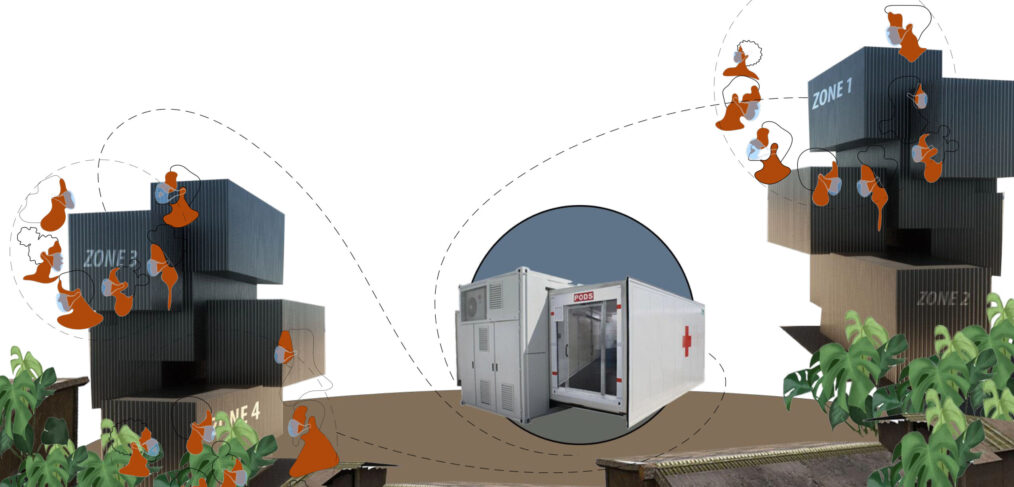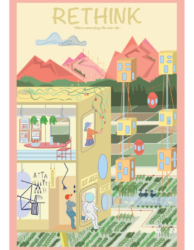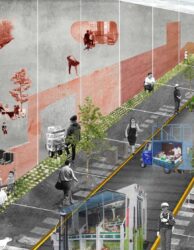
COMMUNAL LIVING IN THE TIMES OF A PANDEMIC
Neady Oduor
Graduate Architect
Dessau International Architecture Graduate School
neadyoduor@gmail.com
- Rituals and communal living.
“Social distancing is reducing physical interaction between people and it lowers the chances of spreading illness between people. Practice social distancing by putting space (at least 6 feet) between yourself and others.” (CDC 2020)
The Bukusu people of rural Kenya await circumcision season annually; the ritual, a rite of passage for adolescent boys ushering them into adulthood. These ceremonies were cancelled in 2020 due to Covid-19 restrictions. In the same way the Luo people of Western Kenya known for elaborate funeral and burial rites to transition their dead to the spirit world have had to stop in adherence with restrictions. Elsewhere Nigerian and Brazilian churches were forced to halt in-house services. 2020´s Ramadan celebrations by Muslim faithful contrasted the regular as fewer Muslims broke fast together and the pilgrimage to Mecca cancelled.
These are but some of the communities that have had to forfeit cultural rituals in the wake of the pandemic. The importance of rituals is understated. With a global pandemic previously having been decades behind us, humanity as a collective has not had to grapple with not having rituals to ground them socially.
In the spirit of adjustment, rituals have moved online, a privilege that may not be afforded to communities that are most attached to rituals. The resistance to ending the rituals is considered irrational but it must be noted that the resistance to regulation pushes more people to break distancing regulation. The Luo people for example took to ambushing burial processions and holding the body until proper rights were observed posing a risk to themselves and health officials. This is probably because communal governance is done differently from government policy. An in between that caters to communal needs while also adhering to regulations should be addressed.
It is worth noting the dichotomy between need for ritual and community living, how the ceremonies have woven a way of life for people over generations, intertwining with the survival and ordering of a community.
1.1 The Paradox of social distancing.
Social denotes need for community, distancing denotes separation. To be separate while in community is negation. The pragmatic term is probably physical distancing. There are communities for whom survival is dependent on “social non distance”.
The women in rural Kenya that run cooperative groups to distribute funds, food and supplies around villages, the weekly produce markets by small scale farmers ,Slum dwellers who cannot practice household quarantining, refugees in camps where the 6ft rule is far from enforceable with Moria camp in Greece having 204 people per square metre.
Physical distance enforcement raised questions about spaces we inhabit, are homes enhancing physical and mental wellbeing? How crucial is public space in a time of physical distancing? Critical thought is minorly directed at the spaces of communal living, probably due to the self-build nature of these spaces. Communal space-making is often borne out of need to survive outside of exclusionary formal structures such as urban planning.
There is an understated privilege to physical distancing.
Urban areas have somewhat managed to enforce distancing, one cannot ignore however the cultural differences between communal living areas and formal urban spaces. Communities in rural areas, slums and refugee camps are overpopulated and rely on their collective activities for survival. Cases in these areas remain lower than expected. In the case infection rates go up, minimal access to healthcare, testing and quarantining facilities presents inconceivable peril.
How then with consideration of economic, socio-cultural and political implications does communal space design facilitate the regulations needed to avoid and contain infection?
1.1.1 Communal living design peri- and post-pandemic.
Utilising this sense and need for community to combat the spread of the virus is crucial. Design strategies should work with communities by treating each community as a unique functioning ecosystem as opposed to a microcosm of the larger context.
Communal spaces could prove beneficial to stretching out services that would however not reach the larger populations of communal living spaces. Zoned centres could be beneficial to testing, with testing booths that work with scheduled visits from zoned areas of the community. Zoning and scheduled movements could also extend to economic and social services such as market days, food distribution and contact tracing.
Liaising with community leaders could help with setting of specific guidelines. Rituals such as burials can still involve cultural traditions that are necessary without posing a threat of infection. A group of trained community members could be involved in burials with family members. Transition celebrations could involve fewer community members. Community leaders could also be crucial for dissemination of credible information within their communities.
Government, planners and policy makers must facilitate expansion of the sites for communal living. Quarantine centres, isolation wards, medical emergency centres are all forms of new infrastructure that are dire especially for slums and refugee camps. Spaces not used during lockdowns could be repurposed, new spaces made during the pandemic should be flexible with changing periods peri-pandemic. Portable housing should be considered for post-pandemic living. Flexible easy to put up and take down structures could act as temporary fix. Infrastructure improvement should however be considered for the long term, the pandemic has after all laid bare the inequalities that already exist within planning and policy.
We have been presented a unique opportunity to reconsider the strategies for urban and community planning and designing. A post pandemic world should shift from the world as we knew it, we might at this epoch be preparing for other pandemics or natural disasters, we must analyse and speculate how the communities around us will exist. We have to envision viable ways of augmenting the self-build culture of the marginalised communities around the world.
References
Architecture post COVID-19: the Profession, the Firms, and the Individuals (2020). Available at: https://www.archdaily.com/939534/architecture-post-covid-19-the-profession-the-firms-and-the-individuals (Accessed: 1 November 2020).
Covid-19 Affects Circumcision in Kenya | Transcontinental Times (2020). Available at: https://www.transcontinentaltimes.com/covid-19-affects-circumcision-in-kenya.html (Accessed: 21 October 2020).
Fans of Kenyan musician prevent burial under ‘swift’ COVID-19 rules | Africanews (2020). Available at: https://www.africanews.com/2020/06/15/fans-of-kenyan-musician-prevent-burial-under-swift-covid-19-rules/ (Accessed: 20 October 2020).
Guidance on Community Physical Distancing During COVID-19 Pandemic – Africa CDC (2020). Available at: https://africacdc.org/download/guidance-on-community-social-distancing-during-covid-19-outbreak/ (Accessed: 1 November 2020).
Imber‐Black, E. (2020) “Rituals in the Time of COVID‐19: Imagination, Responsiveness, and the Human Spirit”, Family Process, 59(3), pp. 912-921. doi: 10.1111/famp.12581.
Making sure rural communities won‘t be left behind in the response to COVID-19 (2020). Available at: https://www.ifad.org/en/web/latest/news-detail/asset/41851548 (Accessed: 21 October 2020).
Ravenscroft, T. (2020) Studio Precht designs Parc de la Distance for outdoor social distancing, Dezeen. Available at: https://www.dezeen.com/2020/04/16/studio-precht-parc-de-la-distance-social-distancing-coronavirus/ (Accessed: 1 November 2020).
Why do we miss the rituals put on hold by the COVID-19 pandemic? (2020). Available at: https://www.sciencenews.org/article/rituals-religion-coronavirus-covid-19-pandemic (Accessed: 26 October 2020).




